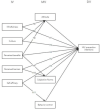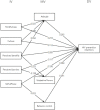A study of the factors influencing HIV-preventive intentions among "hookup" application users
- PMID: 36687841
- PMCID: PMC9846252
- DOI: 10.3389/fpsyg.2022.1048226
A study of the factors influencing HIV-preventive intentions among "hookup" application users
Erratum in
-
Corrigendum: A study of the factors influencing HIV-preventive intentions among "hookup" application users.Front Psychol. 2023 Feb 28;14:1166258. doi: 10.3389/fpsyg.2023.1166258. eCollection 2023. Front Psychol. 2023. PMID: 36925589 Free PMC article.
Abstract
"Hooking up" refers to the act of experiencing sexual intimacy with strangers without committing to a romantic relationship. Social media provide more convenient conditions for hooking up; however, it also poses a greater risk for HIV infection. Therefore, it is necessary to study the factors influencing the HIV-preventive intentions of those who engage in online dating to devise effective strategies for preventing the spread of HIV. This study consisted of a questionnaire that was distributed to 520 users of the Hello Group application. The survey results revealed that structural equation modeling is a useful framework for understanding the risk of HIV transmission in casual hookup encounters. In addition, combining the health belief model with the theory of planned behavior can provide recommendations for enhancing HIV-preventive intentions among users of dating applications. The results showed that mindfulness, the Chinese cultural context, perceived benefits, and self-efficacy were the main predictors of users' HIV-preventive intentions when using online dating applications. Among the perceived HIV risks, only perceived barriers had a negative effect on users' HIV-preventive intentions. In addition, attitude, subjective norms, and behavior control served as mediating variables between independent variables and HIV-preventive intentions; however, the mediating effect of attitude on perceived benefits and intentions was not significant. According to our study, some users misunderstand the risks and make incorrect assessments of the cultural risks of hooking up. Therefore, it is necessary to pay attention to the research on the psychological tendencies of users and risk intervention when studying the concept of hooking up.
Keywords: HIV prevention; SEM model; health belief model; hooking up; mindfulness; planned behavior theory; social app.
Copyright © 2023 Li and Li.
Conflict of interest statement
The authors declare that the research was conducted in the absence of any commercial or financial relationships that could be construed as a potential conflict of interest.
Figures
Similar articles
-
Corrigendum: A study of the factors influencing HIV-preventive intentions among "hookup" application users.Front Psychol. 2023 Feb 28;14:1166258. doi: 10.3389/fpsyg.2023.1166258. eCollection 2023. Front Psychol. 2023. PMID: 36925589 Free PMC article.
-
A Study of Reasons for Self-Disclosure on Social Media among Chinese COVID-19 Patients: Based on the Theory of Planned Behavior Model.Healthcare (Basel). 2023 May 22;11(10):1509. doi: 10.3390/healthcare11101509. Healthcare (Basel). 2023. PMID: 37239795 Free PMC article.
-
Attitudes, norms, and self-efficacy: a model of adolescents' HIV-related sexual risk behavior.Health Educ Q. 1992 Summer;19(2):263-77. doi: 10.1177/109019819201900209. Health Educ Q. 1992. PMID: 1618632
-
Users' acceptance of private automated vehicles: A systematic review and meta-analysis.J Safety Res. 2021 Dec;79:352-367. doi: 10.1016/j.jsr.2021.10.002. Epub 2021 Oct 21. J Safety Res. 2021. PMID: 34848015
-
Growing Up, Hooking Up, and Drinking: A Review of Uncommitted Sexual Behavior and Its Association With Alcohol Use and Related Consequences Among Adolescents and Young Adults in the United States.Front Psychol. 2019 Aug 22;10:1872. doi: 10.3389/fpsyg.2019.01872. eCollection 2019. Front Psychol. 2019. PMID: 31551844 Free PMC article. Review.
Cited by
-
Different Classes of HIV-Preventive Behavioral Intention Among Youths Vulnerable to HIV Acquisition.AIDS Behav. 2025 Apr;29(4):1109-1117. doi: 10.1007/s10461-024-04587-6. Epub 2024 Dec 30. AIDS Behav. 2025. PMID: 39739281 Free PMC article. Clinical Trial.
References
-
- Ajzen I. (1988). Attitudes, Personality, and Behavior. Milton Keynes, United Kingdom: Open University Press.
-
- Ajzen I. (1991). The theory of planned behavior. Organis. Behav. Human Decis. Proc. 50, 179–211. 10.1016/0749-5978(91)90020-T - DOI
-
- Ajzen I., Fishbein M. (1975). A Bayesian analysis of attribution processes. Psychol. Bull. 82, 261–277.
-
- Ajzen I., Fishbein M. (1980). Understanding Attitudes and Predicting Social Behavior. Englewood Cliffs, NJ: Prentice-Hall.
LinkOut - more resources
Full Text Sources






